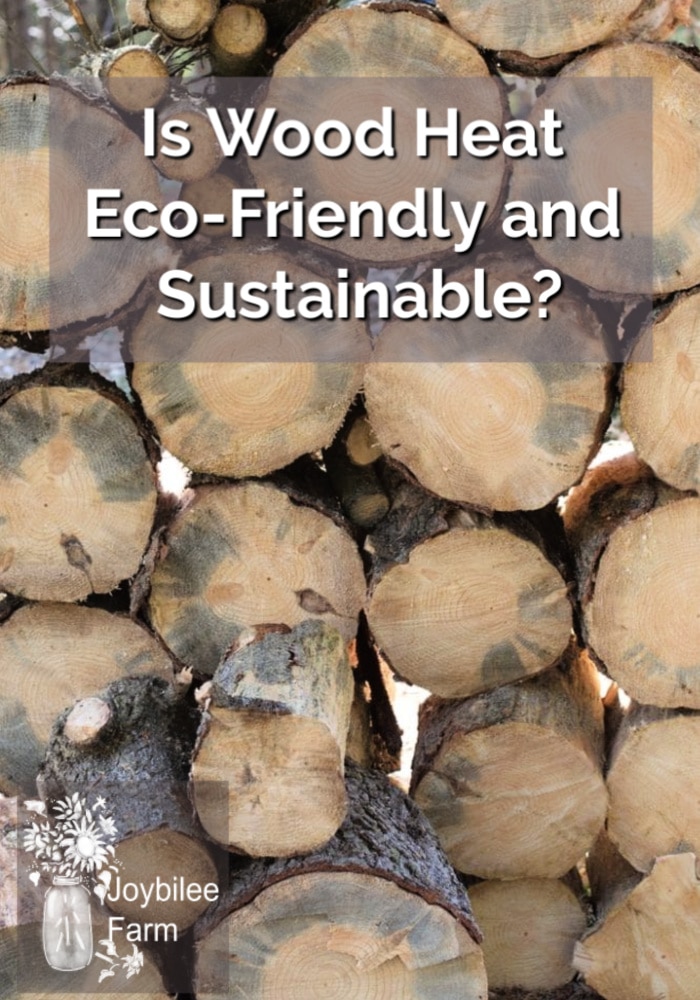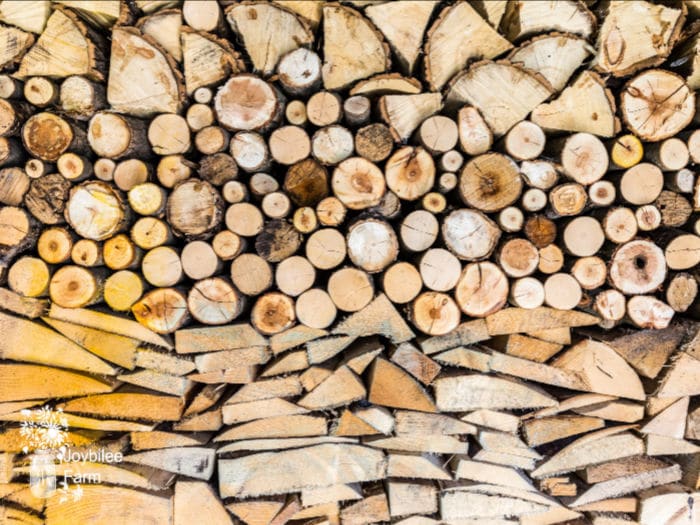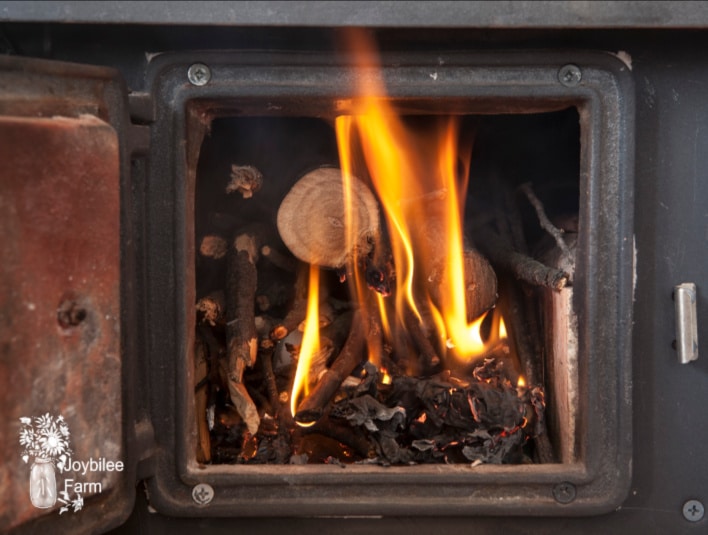Wood heat keeps you warm and reduces your carbon footprint. Although I’m happy with wood as our heat source it is not without issues. Each family must weigh the pros and cons and make their own decision about what’s best in their unique situation.
I’ve been heating with wood for 37 years and cooking with wood for 15 years now. However, there are always some objections that people put out about whether it is sustainable and eco-friendly. I’ve heard them all.
There are some easy solutions, so if you hold to one of these objections, don’t let an easy fix keep you from enjoying the benefits of wood heat and cooking.
1. Cutting trees is unethical
The first question people have when considering wood heat is whether it’s unethical to cut trees. Using wood for fuel doesn’t mean that you have to cut live trees in the wild in a haphazard way. There are ample dead-falls, and standing dead trees in most forest areas.
These trees rot and fuel forest fires and by harvesting them you are helping the forest. Live tree cutting in a sustainably managed wood lot is also ethical and good for the earth. Cutting a fast-growing species like willow can be managed on a rotational basis to provide fuel logs, trees that are coppiced and harvested every 5 to 8 years. The live tree remains in the ground, continuing to grow in a managed coppiced woodlot.
2. Indoor Air pollution is increased by burning wood
Burning green wood creates smoke which increases the particulate matter in the house. Inefficient combustion through using a damaged appliance, burning green or treated lumber, or inadequate draft due to creosote build up in the chimney, cause an increase in particulate matter in the house. This can cause breathing difficulties, increase asthma and other lung diseases.
To minimize indoor air pollution, burn seasoned, untreated wood. Keep the chimney free of creosote build-up by cleaning it as often as necessary, and at least twice a year. Always keep the appliance and chimney in good working condition. Make sure your chimney installation goes straight up from the stove to the roof, to create a good draft and minimize dangerous creosote build-up.

3. Chopping wood is extra work
Yes, it’s a lot of work to haul wood, split it, season, and then carry firewood into the house. “Heating with wood heats you twice” is the old saying. It warms you once when you bring the wood home and the second time when you use it as fuel.
But it is also working to earn the money to pay for the electricity or natural gas to cook with. The rule of thumb is that for every dollar you spend you actually need to earn two, to compensate for the extra expenses of working and the extra taxes that you have to pay for the privilege.
Using wood for fuel can save you money if you live in an area where wood is ample and inexpensive.

4. Wood Heat is inconvenient
There’s no doubt about it, waking up in the morning, turning on the electric stove to get your coffee going (we perk ours), and then turning up the thermostat is just plain easy. Many people do it without even thinking. This method does use fossil fuels, so unless your power is hydro-electric, some fossil fuels are necessary for modern life. It a proven fact that electricity generation has the highest carbon footprint of any home heating option. [source]
On the other hand, hauling wood into the house, lighting the stove, getting the appliance heated up so that you can put on the coffee pot takes work and some thought. The payback comes when the utility bill shows up and when the house is warmed by the radiant heat of the fire and the chill is out of the air.
We’ve found that being able to dip into the water reservoir of our cook-stove all day long and take boiling water for tea is a luxury that offsets the inconvenience of waiting for the woodstove to catch that first burn in the morning.
5. It’s expensive to heat with wood
Heating with wood can be expensive. The expense comes from the initial purchase and installation of the wood heat appliance. You can almost double the cost of the woodstove when you add the cost of installation and chimney into the purchase. The outlay for wood varies from free to $225 a cord around here, your costs will certainly vary. A cord of seasoned wood costs more than a cord of green. Hardwoods cost more than soft woods. Check out fuel costs before you invest in a wood-burning appliance.
Costs can be amortized against the number of years that you use your appliance. The average life span is 15 years for a wood heater and 30 years for a wood cook-stove. After that time, new technologies will come into play and the stoves will be more efficient. Put that against the cost of cooking and heating that you use now to see if it is worth it to you.
When we lived near Vancouver, our old farmhouse was heated with an oil furnace. 35 years ago, it cost us $300 every 6 weeks to refill the oil tank. We bought a Regency Close Clearance wood stove and had it professionally installed with a double insulated chimney. We had to buy all our wood, delivered and split, but our wood-stove paid for itself within 2 winters of use. We replaced it after 15 years with a new, upgraded model.

6. Wood heating is messy
Heating and cooking with wood IS messy. There’s no getting around that. Wood fuels are natural and organic and they leave a trail of debris. A broom fixes the problem indoors and outdoors a rake helps. The mess can be used as mulch in the garden or as a good carbon source in the compost pile.
The ash drawer needs to be cleaned out regularly, from once a week to once a month, depending on the size of your wood box. This leaves another trail of debris. The ash is potash, rich in potassium. If you are burning untreated, seasoned wood, the wood ash is a very good garden amendment. Your beets will love it.
7. I live in an apartment
Apartment living is not conducive to heating and cooking with wood. You can’t clean the chimney and hauling wood up a flight of stairs is not efficient. There is also the dilemma of where to store the woodpile without giving others access to it.
But if you live in a mobile home wood heating and cooking are doable, provided that there are no stipulations in your lease agreement against it.
8. Wood storage is a problem where I live
I hear you. To store 6 cords of wood takes up a lot of space. Sometimes you can make arrangements with the guy you buy your wood from to store your wood for you. Alternatively, start making your plans to move to the country, where space is no longer an issue. 😉

9. My insurance doesn’t allow for wood heating appliances
Some insurance companies penalize you for heating with wood or cooking with wood. Some insurance companies double the cost of your insurance for each wood-burning appliance that you have, others don’t. You’ll need to shop around if changing over to wood heat is important to you.
Your insurance company will insist that your wood appliance is your secondary source of heat and that you must have a primary source of heat. We don’t have natural gas where we live so we have electric baseboard heaters as our primary source of heat.
They rarely get used but they are installed.
10. Heating with wood increases global warming
Wood fuels give off less carbon when burned than they take in during their growth period. This is a negative carbon footprint. The heat effect dissipates quickly from your home and is no different than heating your home with other fuels. When wood is seasoned and your catalytic converter is optimized there is no extraneous particulate matter to increase your carbon footprint.
Take wood from a managed woodlot on your own homestead and you have a very small carbon footprint for your wood-burning appliance.
In a 1998 paper prepared for the U.S. EPA and Air Waste Management Association Conference: Emission Inventory: Living in a Global Environment, “Air Emissions from Residential Heating: The Wood Heating Option Put into Environmental Perspective” (Houk, et als) Wood heat had the lowest carbon emissions per unit of heat than any fuel looked at. Natural gas was in second place with double the carbon emissions of wood.
For more on this, I looked at www.woodheat.org, home of the Wood Heat Organization Inc., a nonprofit, non-governmental agency dedicated to the responsible use of wood as a home heating fuel. Their rule for environmentally sound wood heating:
“Burn sustainably harvested, properly processed and seasoned fuel in an advanced combustion stove or fireplace that is vented through a chimney that runs straight up through the building.”
What’s stopping you from heating with wood?
Are you heating with wood now? Or just thinking about it?

BTU of 25 firewood species chart
Explore the BTU ratings of 25 different firewood species with this downloadable chart and get my best tips for Firewood storage and safety by clicking the pink Free download button below.
Other Articles in the Heating With Wood Series




Oh yeah, faubouls stuff there you!